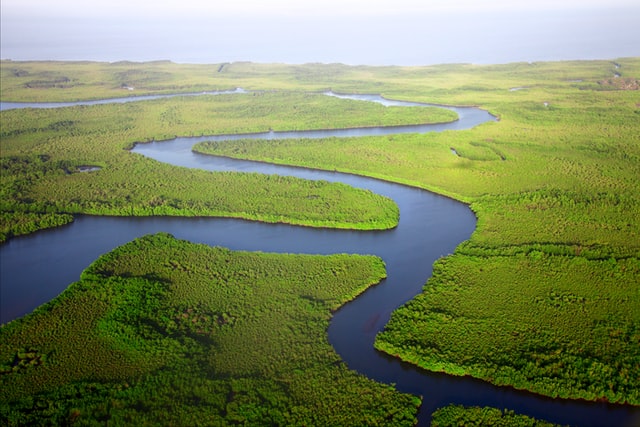Life boats

European scientists have ventured along the Congo River once more, but this time they’re leaving their findings with the locals
Boatloads of pith-helmeted Europeans venturing into Africa’s interior sounds like a colonial relic rather than a means for modern scientific enquiry. Yet in April, to mark both the Year of Biodiversity and the 50th anniversary of the Democratic Republic of the Congo’s independence, just such an expedition was mounted by Belgium’s Royal Museum for Central Africa in Tervuren, and b.spirit! photographer Kris Pannecoucke was fortunate enough to be chosen to accompany them.
“I think my experience working in DRC for Unicef helped, and that I had worked for National Geographic,” explains the Belgium-based snapper. Boarding boats in Kisangani, in DRC’s northern Orientale province, the 67 ornithologists, biologists, geologists, anthropologist and linguists travelled downstream surveying remarkably uncharted waters.
“Congo is not well known to science if you compare it with areas like the Amazon or Borneo,” says the expedition’s organiser, Dr Erik Verheyen of the Royal Belgian Institute of Natural Sciences. “Much of the information dates back to the colonial era, and sometimes to the early part of the 20th century.”
Though the scientists are still going through their results, they’ve already uncovered six new animal species – two frogs, two dragonflies and two shrews – as well as countless archaeological, linguistic, environmental and biological findings, which they’ve yet to digest.
Even more hearteningly, and in a break from the colonial times, the expedition is leaving its boats, books and instruments with the local University of Kisangani, so that Congolese scientists may continue the important research that this expedition has started.
Bateaux de survie
Des scientifiques européens se sont à nouveau aventurés le long du fleuve Congo, mais cette fois, ils ont laissé le fruit de leurs découvertes aux populations locales
Des bateaux remplis d’Européens portant des casques de safari et s’aventurant au cœur de l’Afrique… Cela ressemble plus à un reliquat de l’histoire coloniale qu’à une expédition scientifique de notre temps. Et pourtant, en avril dernier, une telle expédition a été mise sur pied par le Musée royal de l’Afrique centrale de Tervuren, dans le cadre de la célébration des 50 ans de l‘Indépendance du Congo et de l’Année de la Biodiversité. Le photographe de b.spirit!, Kris Pannecoucke, a eu la chance de pouvoir accompagner l’équipe.
Je pense que mon expérience auprès de l’Unicef en RDC et mes diverses collaborations à la revue National Geographic, furent précieuses, » explique le photographe basé en Belgique. Après avoir embarqué à Kisangani dans la province Orientale, au nord de la RDC, une équipe composée de 67 ornithologistes, biologistes, géologues, anthropologues et linguistes, ont navigué en aval du fleuve pour y étudier ses habitats incroyablement préservés.
Le fleuve Congo n’est pas bien connu du monde scientifique, en comparaison de l’Amazone par exemple ou de régions comme Bornéo, » confie l’organisateur de l’expédition, le Dr Erik Verheyen, de l’Institut royal belge des sciences naturelles. « Une majeure partie des informations dont nous disposons remontent à l‘époque coloniale, ou parfois même au début du XXème siècle.
Bien que les scientifiques soient toujours en train d’analyser les résultats de leurs explorations, ils ont déjà découvert six nouvelles espèces animales – deux grenouilles, deux libellules et deux musaraignes – sans compter les innombrables trouvailles archéologiques, linguistiques, environnementales et biologiques, qu’il leur reste encore à assimiler.
Mais, à la différence des temps coloniaux, l’expédition a cette fois-ci, chaleureusement laissé ses bateaux, ses livres et ses instruments à l’Université locale de Kisangani, afin que les scientifiques congolais puissent continuer l’important travail de recherche initié par ce projet.
Reddingsboten
Europese wetenschappers waagden zich nogmaals langsheen de Kongo rivier, maar deze keer dienen hun vondsten de plaatselijke bevolking
Bootladingen vol Europeanen met safarihoeden die zich in het Afrikaanse binnenland wagen, doen ons meer denken aan het koloniale verleden dan aan een moderne manier van wetenschappelijke onderzoeksvoering. Toch werd afgelopen april, ter ere van het Jaar van de Biodiversiteit en de 50ste verjaardag van de Onafhankelijkheid van de Democratische Republiek Congo (DRC), dergelijke expeditie in het leven geroepen door het Belgische Koninklijke Museum voor Midden- Afrika in Tervuren. Kris Pannecoucke, fotograaf van b.spirit!, was een van de gelukkigen die werden geselecteerd om de expeditie te vergezellen.
Ik denk dat ik mede gekozen ben op basis van mijn ervaring als werkkracht voor Unicef in de Democratische Republiek Congo en mijn werk voor National Geographic », aldus de fotograaf die in België woont. In Kisangani, de noordoostelijk gelegen provincie van de DRC, gingen in totaal 67 passagiers aan boord; ornithologen, biologen, geologen, antropologen en taalkundigen. Van hieruit ging het stroomafwaarts, langsheen opmerkelijk ongerepte wateren.
Congo werd op wetenschappelijk gebied nog weinig verkend in vergelijking met gebieden zoals de Amazone of Borneo », vertelt de organisator van de expeditie, Dr. Erik Verheyden van het Belgisch Koninklijk Instituut voor Natuurwetenschappen. « Een groot deel van de informatie waarover we beschikken dateert uit het begin van de 20ste eeuw.
De wetenschappers zijn nog volop bezig met het doornemen van hun resultaten. Toch hebben ze al zes nieuwe dierensoorten ontdekt – twee kikkers, twee libellen en twee spitsmuizen. Daarnaast beschikken ze over talrijke nieuwe archeologische, taalkundige, milieukundige en biologische vondsten die ze nog moeten analyseren.
En er is nog meer opbeurend nieuws. De boten, boeken en meetinstrumenten van de expeditie zullen worden overgedragen aan de plaatselijke Universiteit van Kisangani zodat de Congolese wetenschappers het belangrijke onderzoek dat de expeditie opstartte gewoon kunnen voortzetten. Van een breuk met het koloniale verleden gesproken.

